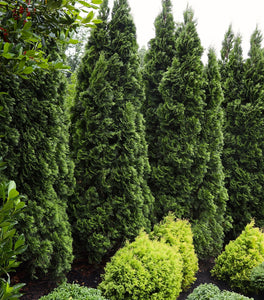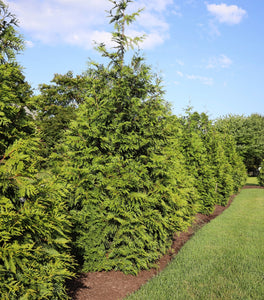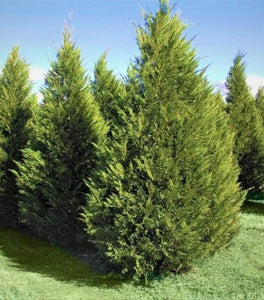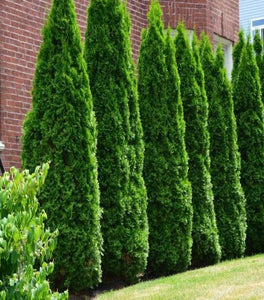Images Depict Mature Plants
Full Speed A Hedge® Thin Man® Arborvitae for Sale
As an extremely thin version of the Full Speed A Hedge® American Pillar Arborvitaes, the Full Speed A Hedge® Thin Man® Arborvitaes are the perfect option for smaller space landscaping in need of privacy.
Reaching a mature height of 12 to 15 feet, and a width of three to five feet, the Thin Man Arborvitae is ideal for a range of landscaping products. Loved for its slim stature and fast-growing nature, it's a no-brainer as to why this tree is rising in popularity!
Beyond the extremely narrow, columnar habit, these trees also hold their vibrant green hues throughout the year! Bring bold color and beauty to your yard year-round when you incorporate the Thin Man Arborvitae into your landscape!
| Hardiness Zone: | 3-8 |
|---|---|
| Mature Height: | 12 to 15 Feet |
| Mature Width: | 3 to 5 Feet |
| Sunlight: | Full sun |
| Foliage color: | Dark green |
| Soil Conditions: | Any type of soil |
| Water Requirements: | Water until established |
| Growth Rate: | 3-5 feet per year |
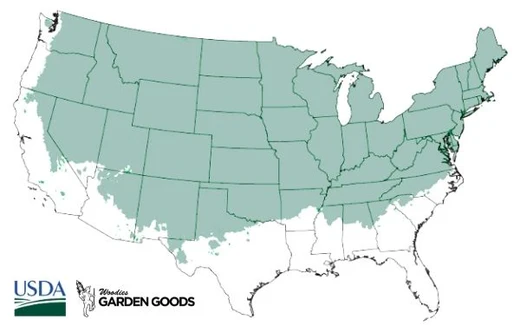
How to Care for Full Speed A Hedge® Thin Man® Arborvitae
Follow these care and planting instructions to let your Full Speed A Hedge® American Pillar Arborvitae grow happy and healthy for years to come.
How do I plant an Full Speed A Hedge® American Pillar Arborvitae?
Plant the Full Speed A Hedge® American Pillar Arborvitae at 4-foot intervals and you'll have privacy in a short amount of time. Our “Buy 10 Plants” package will cover 40 linear feet of space. Never plant Full Speed A Hedge® American Pillar Arborvitae Trees deeper than initially planted in the pot. Doing so can cause rotting of the stem and death to the tree. Dig the soil to a depth of 8 to 12 inches. Remove enough soil from the hole or trench so that the plants sit just an inch or so below the final level of the ground. Laying a stick across the hole is a good way to check this. Make sure the soil underneath is firm, so that your plant will not be pushed deeper as you plant. When planting a hedge, prepare a strip of ground at least 2 feet wide, and preferably 3 feet wide. For a specimen, prepare a circular area 2 to 3 feet across. Bury soft green weeds as you dig, but remove the roots of weeds, especially big perennial ones.
What fertilizer is recommended for a Full Speed A Hedge® Thin Man® Arborvitae Tree?
We recommend when planting your Full Speed A Hedge® Thin Man® Arborvitae Trees to use Bio-tone Starter Fertilizer by Espoma. We have tried many so-called "starter fertilizers" over the years and have come to rely on Bio-tone exclusively for our use. Simply mix the recommended amount of Bio-tone into the back-fill soil and water in generously when back-filled. The "good" fungus in Bio-Tone colonizes on the growing roots of your newly planted tree and does not allow the disease-causing fungus to attack the new roots. It has also shown promise in stimulating the growth of the new roots which means a quicker establishment for your plant.
How often do I water an Full Speed A Hedge® Thin Man® Arborvitae?
After the Full Speed A Hedge® Thin Man® Arborvitae Tree, give is a slow, deep watering. Most of the water you put on the plant at first will run away from the plant until the soil is soaked. A general rule of thumb is to count to 5 for every one gallon of pot size. For example, a one-gallon pot would be watered until you count to 5, a three-gallon pot would be 15, and so on. Check the plant daily for the first week or so, and then every other day after that. Water using the counting method for the first few weeks. More plants die from being over-watered rather than under-watered.
What kind of mulch works best with an Full Speed A Hedge® Thin Man® Arborvitae?
We highly recommend that you mulch your trees with either a ground hardwood mulch or a ground cypress mulch depending on your local availability. Any type of mulch will do, but cypress or hardwood mulch will be of a higher quality and provide better nutrition overall as they breakdown. Mulching helps to keep weeds away which will compete with your new investment for water and nutrients. A 2 to 3-inch layer of mulch is sufficient but remember to take care not to cover any part of the stem of the plant with mulch. It is better to leave a one-inch gap of space between the mulch and the stem or trunk of the plant.





